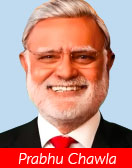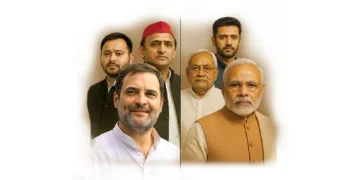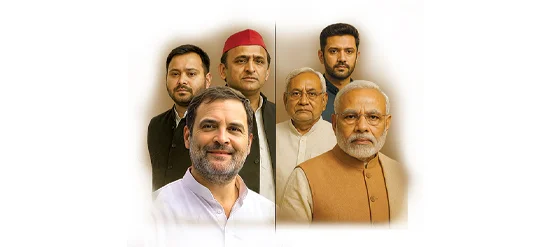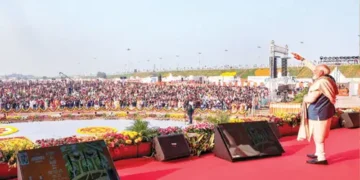 ELECTIONS are the anvil on which democratic destinies are determinatively decreed and new leaders are shaped. They catalyse revolutionary reconstitutions, consecrate nascent nomenclatures, and consign erstwhile titans to temporal twilight. In Bihar’s 2025 Assembly apotheosis, 243 constituencies constitute not mere mathematical markers. It’s a high-stakes democratic delta where destinies go toe to toe, duelling dramatically. Three titans – Nitish Kumar, Tejashwi Yadav and Rahul Gandhi – stand at the precipice of political purgatory, their legacies at stake in liminal uncertainty. Two castecentric coalitions, JD(U) and LJP, engage in existential combat for survival, while the BJP’s bureaucratic behemoth and the INDIA bloc’s fragile federation face their most formidable examination.
ELECTIONS are the anvil on which democratic destinies are determinatively decreed and new leaders are shaped. They catalyse revolutionary reconstitutions, consecrate nascent nomenclatures, and consign erstwhile titans to temporal twilight. In Bihar’s 2025 Assembly apotheosis, 243 constituencies constitute not mere mathematical markers. It’s a high-stakes democratic delta where destinies go toe to toe, duelling dramatically. Three titans – Nitish Kumar, Tejashwi Yadav and Rahul Gandhi – stand at the precipice of political purgatory, their legacies at stake in liminal uncertainty. Two castecentric coalitions, JD(U) and LJP, engage in existential combat for survival, while the BJP’s bureaucratic behemoth and the INDIA bloc’s fragile federation face their most formidable examination.
Nitish, the battle-hardened gladiator, confronts his most consequential challenge yet. Five times he has helmed Bihar’s hierarchical history, but 2025 may be his ultimate political purgatory. His JD(U), once a dominating dynamic, has decisively deteriorated, its voting vitality sliding from 22.6 per cent in 2010 to a mere 15.7 per cent in 2020. Antiincumbency is his implacable ideological adversary after two decades of dominion. His administrative achievements, like infrastructural improvements, electrical enhancement and ameliorated order, remain undeniably documented, but fade against the formidable fatigue of electoral ennui. Unemployment gnaws at Bihar’s soul, with 7.5 million of its people toiling outside the state.
Migration is a wound that refuses to heal. Nitish’s switches between blocs have earned him the stinging moniker ‘Palturam’. He must deliver a majority to keep JD(U) relevant in the NDA, which projects him as its chief minister candidate. This projection irks some BJP leaders, who crave a larger role.
THE largest role in state politics right now is being played by Tejashwi Yadav, the 35-yearold heir to Lalu Prasad Yadav’s RJD legacy, who steps into the arena as an energetic warrior. His father, a political colossus compromised by corruption controversies, remains sidelined by illness, unable to campaign contributively. This is Tejashwi’s moment to prove he is more than a dynastic cub.
Leading the INDIA bloc, he anchors his campaign on the Muslim-Yadav base, a loyal coalition that powered RJD to 75 seats in 2020, making it Bihar’s largest single party. He must now expand his reach to other OBCs, Dalits, and weaker sections to challenge the NDA’s broader caste net.
With a sharp, youth-focused and tech-savvy campaign, he spearheads his war machine. According to an opinion poll, his 36.9 per cent approval rating as a preferred chief minister dramatically dwarfs Nitish’s 18.4 per cent.
Transposing the devious French statesman Tocqueville’s analysis of democratic equality, the Lalu scion represents the generational transition of political legitimacy where inherited authority must prove itself through democratic performance rather than traditional deference. Yet, the RJD carries baggage as the spectre of jungle raj from Lalu’s era and an outdated lantern symbol that rivals gleefully exploit.
New proving ground
Traditional reverence is a right another dynast demands – to be fair, perhaps subconsciously. Rahul Gandhi, Congress’s embattled exemplar, perceives Bihar as his new proving ground. With only 19 seats in 2020, his party is a junior partner in the Opposition bloc; yet its role remains pivotally paramount. This election tests Rahul’s ability to revitalise his party’s fortunes and cement his leadership as INDIA’s prime ministerial prospect. His padayatra alongside Tejashwi and Kanhaiya Kumar hammers issues that resonate with Bihar’s burgeoning youth: unemployment, migration, and economic desperation. Joint rallies with Priyanka Gandhi aim to ignite the Congress constituency, which has withered in recent years.
Rahul’s ‘vote chori’ accusation of bias against the Election Commission has escalated into a public spat, with the Supreme Court seeking cohesive scrutiny. The party’s campaign, centred on the slogan Palayan roko, Naukri do, strikes a symphonic chord in a state where 51.2 per cent of voters cite employment as their paramount priority. Drawing from Nehru’s vision of scientific socialism adapted to Indian conditions, Rahul’s assault represents an attempt to synthesise traditional Congress secularism with contemporary economic populism that reflects a Hegelian synthesis of past idealism with present materialism.
NDA’s unusual hurdle
Idealism, past or present, is not the BJP’s current concern. NDA’s electoral juggernaut faces an unusual hurdle in Bihar: the absence of charismatic local leadership. Narendra Modi’s mass magnetism and Amit Shah’s strategic savvy drive its comprehensive campaign.
Aiming to surpass its 2020 tally of 74 seats, the BJP leans heavily on Modi’s developmental discourse and attacks the RJD’s law-and-order legacy. Polling prognostications provide the NDA a clear competitive edge with 48.9 per cent support against its opponent’s 35.8 per cent. Yet, internal ideological fissures threaten alliance cohesion. Allies like Chirag Paswan’s LJP and Nitish’s JD(U) create considerable friction over seat-sharing arrangements, with LJP demanding 20-25 constituencies while JD(U) resists meaningful concessions.
Paswan, the forty-three-year-old son of the late Dalit icon Ram Vilas Paswan, has emerged as the election’s most unpredictable variable. His party’s comprehensive conquest of five Lok Sabha seats in 2024 underscores his influence among Paswan voters, a crucial Dalit demographic bloc. He seeks significant say in the next chief minister’s selection if neither BJP nor JD(U) secures decisive majority. His sharp critiques of Nitish’s lawand-order record expose fundamental faultlines within NDA solidarity.
The NDA’s carefully crafted caste coalition is complemented by Modi’s massive rallies that promote welfare schemes and infrastructural improvements, contrasting dramatically with allegations of RJD’s administrative anarchy. The RJD’s digital campaign, featuring AI-generated memes and sharp messaging, contrasts markedly with the NDA’s WhatsApp-driven and doorto-door outreach. This mirrors the German political economist Max Weber’s analysis of coalition politics’ inherently unstable arrangements based on temporary convergence of interests rather than fundamental ideological alignment.
Caste political heartbeat
Not ideology, caste remains Bihar’s political heartbeat. As a survey has reflected, issues like unemployment, cited by 51.2 per cent of voters, inflation at 45.7 per cent, and corruption at 41 per cent shape the narrative. The NDA’s broad caste base – Nitish’s Kurmis and EBCs, and Chirag’s Paswans – gives it an edge.
The RJD’s MY BAAP formula – targeting Muslims, Yadavs, Bahujans, Adivasis, and the poor – struggles to expand beyond its core. Prashant Kishor’s Jan Suraaj Party, contesting all 243 seats, pushes a caste-neutral platform, but lags with only 16.4 per cent in the chief ministerial preference poll. Though the Congress’s migration-focused campaign gains traction, the INDIA bloc’s internal rifts hinder its momentum. A loss could spell the end for Nitish, reducing JD(U) to a footnote and its leader to a faded legend.
Bihar’s 2025 election is a defining moment whose outcome will determinatively decide whether the NDA tightens its governmental grip or the INDIA bloc discovers new vitality. Bihar’s voters wield ultimate authority as their verdict will not merely crown the next chief minister, but fundamentally establish the foundation for India’s political future. In the end, their democratic decision will reverberate through the corridors of power, creating ripples that reshape the republic’s revolutionary trajectory
































